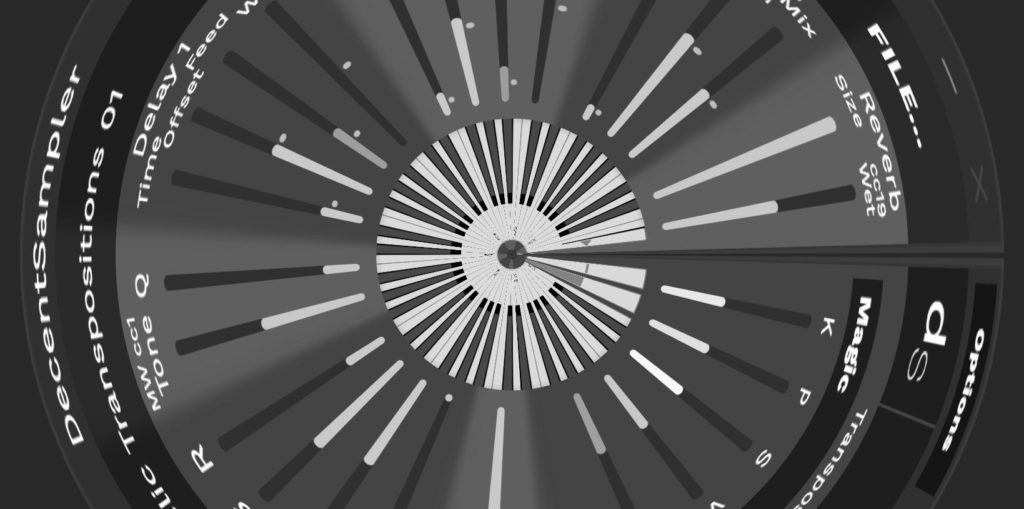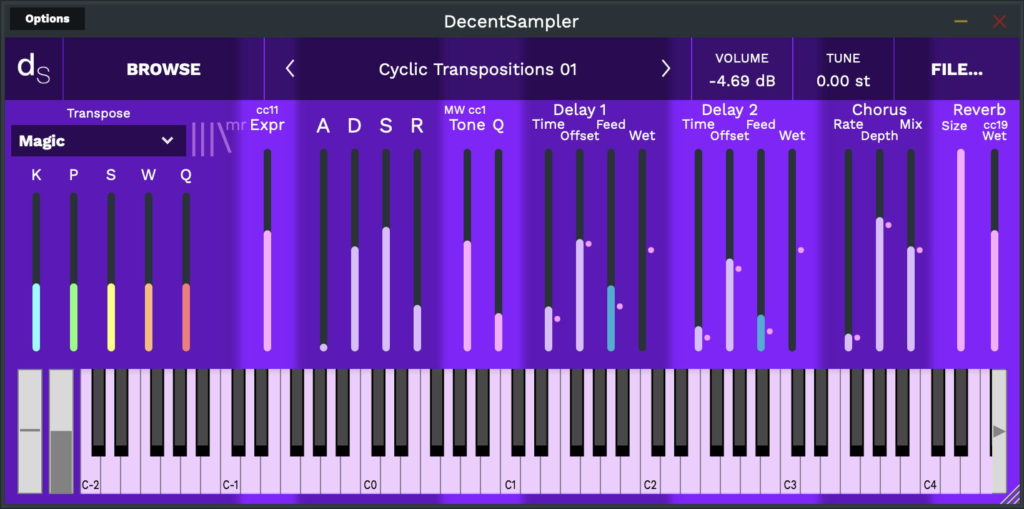
The story
A long time ago, there was ‘Parallel Inversions’. People tried it out, some liked the strange organ-like timbres, and many didn’t understand what was happening ‘behind the scenes’, but it was definitely unusual…
My Virtual Instruments (Sample Packs in Pianobook.co.uk-speak) tend to take little incremental steps. Ideas for strange things are often tested out as minor features where they can be easily overlooked. And that’s what Parallel Inversions was: my first attempt at something ‘outside of the box’ and a little bit ‘unusual’.
Cyclic Transpositions is the next step in this exploration of the ‘not ordinary’ side of Decent Sampler. If you want a safe, steady, quiet life, then keep the drop-down menu in the top left of the ‘as always’ scarily busy user interface, set to ‘None’, and you have a straight-forward synthetic timbre – sometimes a bit like a piano, but definitely not realistic, and sometimes like a pair of slightly detuned 70s string machines… No challenges, no excitement, nice and mundane…
But if you try out the drop-down menu, then prepare for a trip into relatively unknown territory, where things are different. This is a place where round-robins are mis-used and are not birds, and where the keyboard or MIDI Input is cruelly processed without mercy. There’s no going back, and once you have heard the two ‘Magic’ settings then you will be unable to resist! More grist to the mill!
And that’s a quick glimpse into what you have downloaded – or are about to! Buwahahaha!
– – – – –
Here are some notes on how it works, and how you can use it.
The User Interface (UI) may look scary and complex at first, but don’t panic!
Lets break it down into sections:
Left-hand panel
On the left, there’s a darker area with a drop-down menu label ‘Transpose’ (it was originally going to be called: ‘Madness’), and 5 vertical sliders.
The drop-down menu has 12 options for the dynamic transpositions:
= None – safe, perfectly ordinary, virtual instrument. Okay for everyday use
= -1 sync random – Inspired by Victor Borge, this turns your playing into error-prone minor masterpieces…
= +-5 and +-12 – several variations on auto-transpositions, in various flavours. Just play…
= Magic I and II – CH might love these. Completely OVER-THE-TOP, but gorgeous in the right context!
(Just don’t try to figure out what is happening! Try hocketing, 8 or 4 velocity layers, 5 round-robins…)
There’s a lot happening in Decent Sampler with this Virtual Instrument / Sample Pack. It is probably best to not play too many notes at once, and try to keep the ‘Release’ slider low, otherwise you may hear note stealing.
The options to try first are probably the +-12 ones, with the ‘rr’ round-robins ones being the most suited to comping, whilst the ‘random’ ones are more suited to melodies. The +-5 options are definitely not suited to Jazz use, so simplicity is key for these. No Giant Steps solos, please!
The 5 rainbow coloured vertical ‘pony’ slider boxes let you set the colour scheme of your unicorn – variations are automatically applied to colour the mane and tail….. Sorry, wrong piece of software.
The 5 rainbow coloured vertical ‘mic’ slider boxes let you control the volume of five different component timbres: percussive on the left, to sustained on the right. The letters above each slider are from early development, and hint at the way that the sounds were produced. None of these are samples, they were all produced mathematically and there may be more coming in CT 02, 03…. For the avoidance of doubt: W and Q are not samples – they were produced mathematically. Not that this means that later versions won’t have samples in them, of course…
Ordinarily, I would advise against having all five of the rainbow sliders set to mid-position – too much polyphony is consumed! But in this case, the dynamic transpositions work best when all five sliders are set to some value other than zero! Especially the ‘Magic’ settings! And I will be hugely disappointed if I don’t hear something using the Magic setting in something on TV or in the Movies in the next year or so!
Right-hand panel
To the right, there is one large panel, split into seven darker or lighter areas.
From the left to the right, the first one is the Expression control mapped to MIDI CC 11, a vertical slider which controls the output volume of Decent Sampler.
The next darker area has four vertical slider controls which let you set the way that the sound starts, decays, sustains at a fixed level, and ends. The ‘A’ slider is the Attack time – the start of the sound. Up is slow, down is fast. For drones, this will usually be set high so that the sound will start slowly. The ‘D’ slider is the Decay time – what happens after the attack. The ‘S’ slider is the Sustain level, which is where the sound ends up when you hold a key down. Finally, the ‘R’ slider is the Release time – how long it takes for the sound to fade away after you stop hiding the key down. So the sound gets louder at the rate set by the attack time, until it reaches maximum, then drops down to the sustain level, at the rate set by the decay time, and it stays at the sustain level until the key is released, and then it fades away at the release time rate.
The next area is lighter, and has two sliders. The Tone slider controls the cut-off frequency of a 2-pole low-pass filter high is open, letting all frequencies through, low is closed, letting only low frequencies through – the Tone control is mapped to MIDI CC 1: the Mod Wheel the grey bar next to the virtual keyboard. The Q’ slider adjusts how resonant the filter is – how much it accentuates frequencies around the cut-off frequency. The ‘Q’ control is a bit tricky – raise it slightly and the sound changes in volume, so be careful! Don’t be afraid to try moving the Tone and Q sliders around – there is a lot of control over the timbre available! The rainbow timbres K P S W Q are deliberately bright, so that you can cull harmonics using the Tone control and the Q control. Have no mercy – filter those high frequencies out like it’s 1999…
The next area is darker, and contains one of the four audio effects in Cyclic Transpositions 01: the Delay effect creates echoes. There are four vertical sliders. The first is Time, and this sets the delay time up = slow, down = fast. The slowest delay is about 10 seconds, the fastest is almost immediately. The little pink dot on the right of the slider is there to remind you of the basic ‘home’ position – a mid-range setting that is probably a good starting point for exploration. If you get confused, then just set the sliders back to the dots and you should be back in control! The Offset slider adjusts the time for the left and right stereo channels, so the sound moves from side to sound in the stereo field. In the middle, near to the grey dot, the left and right channels will be delayed by the same time, but as you move the slider away from the middle, then the two channels will have more and more different delay times. The next slider is the Feedback control, and this is coloured blue so that it is easy to see in the sea of purple and pink. If you change the delay time, then you may hear all sorts of weird pitch changed echoes, and one way to get rid of them is to reduce the feedback to zero for a few seconds, let them decay away, and then set the feedback back to where it was again. So if you want to remove the weirdness, then just pull the blue slider down for a few seconds and you will hear them stop, then put it back up again. Easy! The final slider in this area is labelled ‘Wet’, and controls the volume of the echoes – the ‘Dry’ sound is always audible.
If something is worth including, then it might be worth including it again – so the next effect is another delay! Cyclic Transpositions works very nicely when subjected to step sequenced music (The Arturia KeyStep is very nice!), and so double delays can be very useful for creating complex echoes to make the sequences sound much cleverer than they actually are.
The next area is darker, and has three vertical sliders for the ‘Chorus’ effect. This makes it sound like the sound is detuned. The Rate slider changes the speed of the wobbling of pitch. The ‘Depth’ slider controls the amount of pitch wobbling. The ‘Mix’ slider controls the Dry/Wet mix. As with the Delay effect, the Chorus effect also has little pink dots that show you where to set the sliders if you get lost with making changes. Slow is probably your instinctive speed for the Rate of the chorus, but when using a step sequencer then you might find that faster rates are surprisingly interesting…
The final area on the right hand side is lighter, and has only two sliders. They control the Reverb effect…Yes, there are four effects in cyclic Transpositions 01, almost a guitar pedal board!.The ‘Size’ slider sets the size of the room that the reverb is emulating, whilst the ‘Wet’ controls is like the Delay ‘Wet’ slider, it only controls the amount of reverberated sound that you will hear. The dry sound is always audible. The ‘Wet’ slider is mapped to MIDI CC 19.
Presets
My user interfaces (UI) are scary for some people, so I have included a few presets. Take no notice of the names, please.
UI User Interface
Yes, the UI background is very simple, and not a photograph! This is because there is so much happening with all of those sliders that I thought a ‘no distractions’ approach was better, so I went a bit purple and pink to keep you calm and collected. Please consider purchasing a purple velvet jacket – it will go with the UI very nicely!
The darker and lighter areas are there to make it easy to see all of the different sections, without the visual clutter of vertical lines – there are enough verticals in all those sliders. There is no need to be intimidated by all the sliders – just concentrate on one of the areas at once and you should be fine. There are always the pink dots to help you return to a default effect, and there’s that UI Video below as well.
Think of it this way: a sophisticated user interface means more sounds and more control. Lots to explore!
MIDI Controllers
1 ‘Modulation Wheel’ controls the Low-pass Filter Cut-off Frequency, the ‘Tone’
11 ‘Expression’ controls the output volume
19 ‘General Purpose 4’ controls the Reverb Wet/Dry mix
The video below shows how the user interface works, although it uses a different instrument as an example.
V2
UI User Interface Video
Interface

Reviews for Cyclic Transpositions 01
- Sound
- Character
- Playability
- Inspiration
- GUI
Leave a review to let others know what you thought of the instrument!
The God of Synth Patches
Bloody hell, that's one god of a synth patch. So many controls, like I was holding a real synth. And the midi mappings allow for control from my smol Arturia Minilab's knobs, so almost feels like I'm holding the Microfreak. This is THE patch. Inspiration is peaking through the roof and unto my neighbour's house when I play this!
One of the best compact sampled synth instrument
Just a lovely and incredibly instrument with striking possibilities and a blend of inspiring sounds. The fantastic transpose (a kind of random sequencer) and the 5 rainbow (KPSWQ) timbres, the very low CPU consumption, make it a real powerful compact virtual synth. (I only found and error parsing the XML when selecting the next one to the last CT1 05 preset). For me this is one of the best compact sampled synth instrument I have found in pianobook.
Love This For Swirling Pads
I really love this synth. It looks foreboding and, if this isn't a contradiction, simplistic, at the same time. Once downloaded I was quickly noodling around creating some deep and swirling pads (which is my thing) and I can see lots of potential with it. Great job. Worth playing around with.
An excellent bundle of synths
This is a very versatile instrument that features a familiar retro synthetic sound, but it's highly customizable, with 5 different main sounds to blend however you want, and a fantastic "transpose" menu that brings extra automated magic to everything. Simply lovely! It plays very well, with full ADSR controls, filters and effects, so it's pretty much a complete package.
The playable range is stretched across the keyboard, with the first three sounds (K, P, S) sounding a little longer in the lower range, and becoming shorter as you go higher, but it's something that's not audible, especially if you add some effects or if you blend in W and Q.
All in all, I think this is one of writer's best instruments.




